US Amazon link for The Wizard’s Tower.
US Amazon link for Rethinking S.W Erdnase.

US Amazon link for The Wizard’s Tower.
US Amazon link for Rethinking S.W Erdnase.
As stated in the title, I uploaded the replacement cover today. The replacement cover is now under review by Amazon.
Approximations of the front covers (current at top, replacement at bottom) are shown below.
If the new cover is approved (and I am pretty sure it will be), that might or might not impact orders placed in the near future.


—Tom Sawyer
August 14, 2023
Below is a front-cover design for my forthcoming book on Professor Hoffmann’s short fiction. I put this together back in June, and at that time I believe my intention was that it would basically be a placeholder. But it turns out that I like it quite a bit, and also I am reluctant to impose on my daughter for a cover for a book that will likely sell very few copies.

If you are puzzled by the title In the Yule-Log Glow, I’m not surprised. Hoffmann’s story “Christmas With the Baron” was first published in London Society in 1863. It has appeared in a number of anthologies, including the four-volume In the Yule-Log Glow, first published in 1891.
There were also at least two one-volume printings of In the Yule-Log Glow.
My cover above portrays Book II from five different sets dated 1892. (That is the earliest-known title-page date for that title.)
But you say that six covers, not five, are shown? Yes, in one case I also showed Book III, as well as Book II from the same set.
—Tom Sawyer
August 11, 2023
For years now, I have had the intention and hope of publishing a book about Professor Hoffmann’s contributions to periodicals, with a focus on his short stories. I am finally about to issue such a work! The current title is Professor Hoffmann’s Short Fiction: A Bibliographical Study of the Fiction of Angelo J. Lewis. (That is subject to change.)
Here is what the table of contents looks like now (again, subject to change):
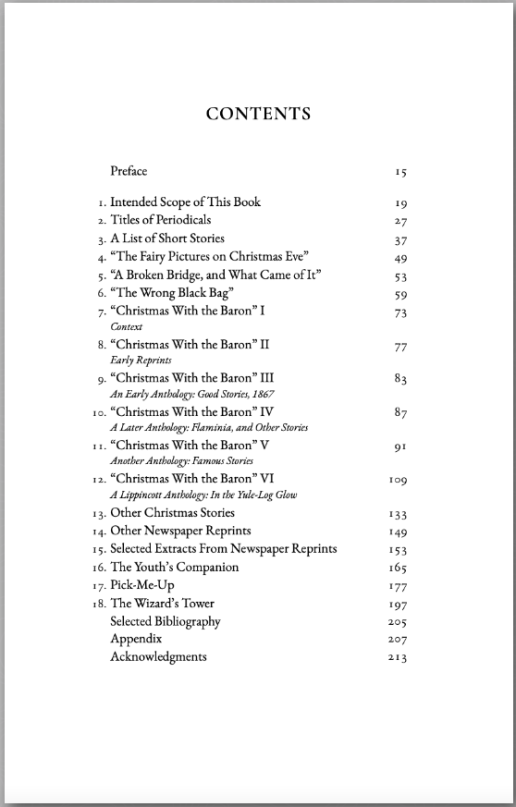
I’ll be providing more details on this blog in the near future.
—Tom Sawyer
August 11, 2023
If you are looking for Plymouth Place on an old map of Chicago, and cannot find it, here are some tips. These suggestions apply to old maps, probably from around 1895 to around 19o5. Much before that or after that, this might not be as helpful. Also, some street names may vary, depending on the map you are looking at. (Based on Google Maps, I think that today’s Plymouth Court is a much longer street.)
And even if you don’t want to consult any old maps, the following is relevant to the whole S.W. Erdnase story.
First, Plymouth Place is located very roughly half-way up the Chicago coastline — not exactly on the Lake Michigan coast, but quite near. On the typical map, you will see an extremely straight vertical section of coast, with a large breakwater in two sections, almost enclosing a section of Lake Michigan. Once you find that breakwater, you have almost found Plymouth Place. It is a north-south street. To the east of Plymouth Place, there are only three main streets running north-south between Plymouth Place and the coast. First there is State Street, then Wabash Avenue, then Michigan Avenue. Then — water!
To the west of Plymouth Place, north-south, is basically Dearborn Street. However, Dearborn Street seems to disappear in one or more places, such as near Dearborn Station, which seems right in its path. And speaking of Dearborn Station, Plymouth Place runs up the eastern side of Dearborn Station, which is located at Polk Street — and for a stretch in that area, the street immediately to the west of Plymouth Place is Custom House Place.
It appears that Plymouth Place (or, if there are other sections of the street anywhere, the relevant portion of it) starts at 12th Avenue, which is an east-west street that lines up pretty well with (or points roughly toward) the south tip of the breakwater. Then from there (that is, from 12th Avenue), Plymouth Place runs northward all the way to Jackson Street, where it seems to come to an abrupt end — while Dearborn, to the west, and State Street, to the east, keep running northward.
As a very rough approximation, I estimate that the Plymouth Place of 1902 (or the relevant segment of it) was approximately seven-tenths of a mile long — more than a half-mile, and less than a mile.
Here is a listing of cross-streets, starting at the north end of Plymouth Place and going to the south end of Plymouth Place:
Jackson Street
Van Buren Street
Harrison Street
Polk Street
Taylor Street
12th Street
The above discussion is based primarily upon two maps on the University of Chicago website. The first one (probably the clearer of the two) shows Chicago “between 1897 and 1899.” The second one shows Chicago, “1892, northeast corner.” (It is actually one-fourth of a larger map.)
(Note of August 9, 2023: I’m not certain that Plymouth Place went as far south as 12th Avenue. When I originally posted this post, I included links to the two maps mentioned. But those links stopped working. Here is a link to a map that is one of the best for Erdnase purposes: Link. Below is a small image of the map, with the main area of interest enclosed within a white box, just to help you find Plymouth Place after you click on the link to the map.)
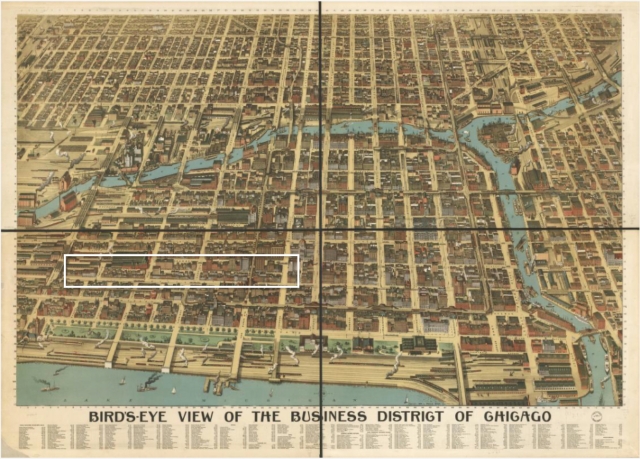
—Tom Sawyer
August 9, 2023
As I mentioned in a previous post, I intend to change the cover design of Rethinking S.W. Erdnase. I will probably upload the replacement design sometime on Thursday, though that is just an estimate. And I am not sure how long it will take Amazon to implement the change.
But, in keeping with what I have already said, if you are interested in securing a copy with the current cover, you would be well-advised to order immediately.
Of course, if Amazon has copies in stock, then timing might not be too important!
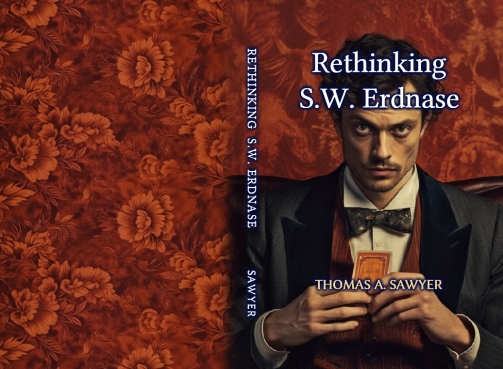
I do think some people are apt to be disappointed, especially if they were to learn just how small the number of copies there are apt to be with the current cover. But—there’s not much I can do about that! “C’est la vie. C’est la guerre.”
But as my daughter sagely pointed out to me, it might turn out that there will be even fewer examples with the replacement cover. Of course, whether more numerous, or less numerous, or neither . . . the copies with the replacement cover will be later copies.
On the other hand, I do think the cover above (which is likely pretty close to what the replacement cover will look like) is overall more attractive. For those who might find the image disorienting: The left-hand section is the back cover. The center part is the spine. The right-hand section is the front cover. The four edges include margins that will not generally be seen.
—Tom Sawyer
August 9, 2023
Note: I am now starting to number this particular series of posts dealing with James McKinney, the address 73 Plymouth Place, and Plymouth Place in general. This post is the fifth in the series. [This refers to a series that appeared on my “S.W. Erdnase: 20 Years Later” blog.]
The address 73 Plymouth Place is a key landmark in the story of S.W. Erdnase.
The reason for this is that the address 73 Plymouth Place is given as the “Residence” of the “copyright claimant” on the 1902 Erdnase copyright application—and also the address of the “applicant” is shown as “care of Jas. McKinney & Co.”—“73 Plymouth Place”—“Chicago, Ill.”
That is based on a reproduction of part of the copyright application form, on page 274 of The Man Who Was Erdnase, by Bart Whaley, Martin Gardner, and Jeff Busby, 1991. That is the only place I have seen any portion of the form—which is interesting, because of the key role that form plays in the entire mystery. (Regarding the “Residence” address, by the way, it looks like “73 Plymouth Pl.”—“Chicago, Ill.” The “Pl.” appears to be crossed out.)
(August 8, 2023 Note: The form (or parts of it) have since been made available elsewhere. You can see images of relevant Jamieson handwriting here: Copyright application information. You may have to scroll-up a bit.)
Of course, the quotation marks shown above do not appear on the form. Also, I may have supplied some punctuation which may or may not be on the original. But the above is pretty close.
One thing I have not seen anybody draw particular attention to is that fact that the 73 Plymouth Place address is given as Erdnase’s “Residence.” I don’t think it is outside the bounds of possibility that people may have been living at the 73 Plymouth Place address. Taking the application at face value, one might conclude that Erdnase was indeed living there. (The other address might be taken as a mailing address, and in that case, Erdnase or his agent perhaps needed to put the “care of,” if he wanted to receive mail.) There are probably other things about the copyright application form that could be discussed, as well.
But anyway, the main point at the moment is that the 73 Plymouth Place address is important, and I don’t know that very much research has been devoted to it. Maybe it has, but if so, I don’t know about it. I am talking about things like who all the tenants were at that address, from (say) 1899 to (say) 1904. I am also talking about things like who all of the neighbors were, up and down the street, for say a half-block in each direction. I don’t even know whether that information could be located, but I am pretty certain that some of it could. I have found out a few things myself, and I’ll probably go into that somewhat in future posts.
—Tom Sawyer
Reposted 8 8 23.
(August 8, 2023 Note: I have made a few slight revisions and stated an additional thing or two, mainly to make things more clear.)
In the preceding post, I outlined some information regarding the 73 Plymouth Place address that is found on the copyright application for “Jas. McKinney & Co.,” presumed to be the printer of The Expert at the Card Table. See The Man Who Was Erdnase, page 274, for a reproduction of part of the Erdnase copyright application. (It is, as I understand it, based on the copyright application—and basically nothing else—that the contention is made that James McKinney & Company printed the book.)
(August 5, 2023 Note: There are probably a few other things that also point to McKinney as the printer. The Erdnase thread of the Genii Forum discusses the fact that McKinney is named in a handwritten note in a copy of the book that had belonged to Adrian Plate, who co-wrote the classic Magicians’ Tricks: How They Are Done, and who has a reputation as having been highly skilled with playing cards. If I recall correctly, this was first mentioned by Richard Hatch, and later elaborated upon by Marty Demarest.)
The main point of the preceding post, and you can read about it in that post, is that a Howard M. Andrews was operating out of that same street address during the same time frame—not a block away, and not five years later, but at the same time and the same address. That to me is unexpected, and it is possible that it has some actual significance, and that it is not simply some coincidence of the type of which I seem to make frequent mention.
If the above signifies nothing else, at least it shows that not all of “the research” has been done relating to the Erdnase-identity question.
Something I have thought for a while . . .
For a while now, I have thought that a key to the whole Erdnase mystery might lie in a close examination of the actual book (mainly the first edition), and the printer (meaning “everything having to do with the printer”). Those who have read David Alexander’s Genii article, reprinted in the September 2011 issue, on the S.W. Erdnase identity question will remember that he advocated a return to the book itself as a kind of immutable constant in the whole inquiry. The book, after all, is the root of all of the questions concerning Erdnase, and it seems as though it might provide at least some of the answers to the remaining questions.
James McKinney . . .
Something tells me that a close investigation of James McKinney, including those who worked with him and for him, and of his area of town back around the turn of the century, might yield some results helpful to an Erdnase investigation. Although a lot of evidence is now gone, there must be many records—public records, newspapers, and periodicals, for example—that now are in essence permanent. Even if the results might do nothing whatsoever to advance the Erdnase-identity investigation, at least some interesting information relating to the era and vicinity could probably be found.
For example, I see on the website of the University of Notre Dame Archives that the university is in possession of an archive of “Notre Dame Presidents’ Letters, 1856-1906.” One of the letters has—as an attachment, apparently from 1895—a letter from James McKinney, The Gothic Printing House. So that might be a means of determining James McKinney’s handwriting, or possibly at least his signature, for comparison to the writing on the Erdnase copyright application.
(August 5, 2023 Note: This was before Chris Wasshuber uncovered the McKinney bankruptcy papers. Of course, we now know that the key handwriting on the copyright application was that of S.W. Jamieson. This is discussed at length on the Erdnase thread of the Genii Forum.)
Advertisements exist from that era, showing James McKinney as “Agent” for The Gothic Printing House, or referring to “The Gothic Printing House of James McKinney.” (I expect to deal with that a little in a future post.)
That part of Chicago . . .
Then there is the situation regarding 73 Plymouth Place and its environs during the period in which The Expert at the Card Table was produced.
My own recent investigations—and I mean really recent, like maybe during the past month, and probably mostly during the past week or two—have thoroughly repudiated most (if not all) of my key preconceived notions about that area of Chicago.
And here, you might wish to play a little game before reading farther. You might wish to picture James McKinney’s establishment in your mind. You might wish to imagine such things as how many employees he had, if any; what his neighborhood was like; what his neighbors were like; how many floors were in his building; whether McKinney dealt directly with his customers; and so on. I am not saying that I know the answers to such questions. I don’t, really. But at least I was able to come up with some guesses, and I will mention some of my ideas below. But if you don’t want to be influenced by my comments, you should probably do some thinking before you read further.
My own vision of James McKinney & Company — some preconceived notions with little or no support . . .
[Remember, this post speaks as of September 5, 2011!]
For some reason, I had pictured McKinney’s printing operation as a small-time operation (one story, probably, or maybe two). He had one main printing press, and the Erdnase job was a big one for him. In my imagined version of McKinney’s print shop, it was an isolated printing establishment on Plymouth Place (a cheerful little location to which you might take a pleasant morning-walk). It was possibly chosen by Erdnase for its unique characteristics, such as proximity to a hotel where Erdnase could meet with an illustrator. And maybe because the printer needed the business, James McKinney would work personally with Erdnase. And it was McKinney who stood at the counter across from Erdnase, as they worked out the details of the project. Remember, I am talking assumptions. These may not have been my exact assumptions, but they were along those lines.
But I have been finding that probably none of those concepts is even remotely accurate. And if any of them are approximations of reality, it is only by chance.
James McKinney & Company: A few of the main facts as I currently understand them . . .
I’m not going to discuss too much in this particular post. The main point at the moment is that there were a lot of printers in the area, and it is possible that Erdnase had some reasons for choosing McKinney that no one has hypothesized about.
Some of the following is a bit speculative, because I don’t know exactly what was going on there in 1902, and I don’t know exactly where McKinney’s place was located with regard to certain other places. I may have tossed in a few anachronisms. But so far I have not seen anything contrary to the following, and I believe that it is at least approximately correct.
James McKinney & Company, 73 Plymouth Place, was located in Printing House Row (also known as Printer’s Row), which was basically the Chicago printing district and the home of many printing companies. One discussion—in Nelson’s Encyclopaedia, Volume 3, New York, 1907, page 73—simply says, “Dearborn and Federal Streets and Plymouth Place are known as Printers’ Row [. . .].” Obviously, by that definition, 73 Plymouth Place would be included. I have read three or four descriptions of what constituted (or constitutes) Printing House Row, or Printer’s Row, and I am not sure that any two were the same. (Apparently there are few printers there today.)
It is more or less to be assumed that many (if not most or all) of the buildings that housed printing activities in Printer’s Row were multiple-story buildings. This seems fairly clear from a 2003 book called Printers Row Chicago, a 64-page pictorial history (for popular consumption, it would appear, to judge from the extracts on Google Books) by Ron Gordon and John Paulett. And that is consistent with all of the pictures that I have seen relating to printing establishments in the Printer’s Row area. One thing I do not understand is the methods that were used to install massive printing presses on anything other than the first floor—even there, I imagine it would be difficult.
Anyway, even allowing for a certain amount of mobility, the “printing house” (and printing supply) nature of many of the businesses on Plymouth Place is clear. The following is nothing like a complete list.
W.F. Hall Printing Company — 21-25 Plymouth Place (per Official Proceedings of the Western Railway Club for the Club Year of 1898-9, Chicago, 1899).
Golding & Co. (printing presses) — 45 Plymouth Place (per The Inland Printer, July 1891).
W.B. Conkey Company — 78-88 Plymouth Place (The Inland Printer, April 1891). (Also, per The American Bookmaker, January 1894, also, 63-71 Plymouth Place. Then ad advertisement in the May 1894 issue omits mention of the 78-88 address.)
H.H. Latham (printing presses and binding equipment) — 87-91 Plymouth Place (per The Inland Printer, June 1891).
T.W. & C.B. Sheridan (book manufacturing equipment) — 136 Plymouth Place (per The Inland Printer, July 1891).
Chicago Electrotype & Stereotype Co. — 149-155 Plymouth Place (per The Inland Printer, April 1899).
I hope to return to this topic soon.
—Tom Sawyer
From 9-5-11
Reposted 8-8-23
As stated in the title of this post, I hope to change the cover of Rethinking S.W. Erdnase. The new front-cover will likely look very much like this:

This change may take place at any time, but it is likely to be implemented within the next few days.
Meanwhile, if you want a copy with the current dark, semi-mysterious cover, you would be advised to purchase a copy immediately. That cover is shown below:

If you have already ordered a copy, thank you very much!
—Tom Sawyer
August 8, 2023
August 5, 2023 Introductory Note: This post takes a long time to say very little. The main thing of interest is that there was a guy named Andrews with a business address of 73 Plymouth Place (same basic address of McKinney, the putative printer of The Expert at the Card Table). This was so, at about the time the book was printed.
We know that James McKinney’s company had the address of 73 Plymouth Place, Chicago, when they printed The Expert at the Card Table in (presumably) early 1902. Apparently they continued at that address until at least (I gather) early 1903, or so, according to information quoted by Bill Mullins on the Genii Forum (page 8).
Based on a certain amount of research on Google, I have concluded to a fair degree of certainty that the addresses on (at least) that stretch of Plymouth Place were also the same (probably generally later) addresses on Plymouth Court. I looked at an early map that showed Plymouth Place, and not Plymouth Court, so I suspect that the name of the street changed to Plymouth Court (at least on that stretch). (But that was not really part of the research from which I made the conclusion stated in the first sentence of this paragraph.)
Also, that area was apparently home to a lot of printers. Moreover, in The Inland Printer, October 1909, reference is made to a printer (not McKinney) using “five floors at 73 Plymouth place.” (I expect to talk about that further in a future post.) I suspect it was also a multi-story facility in 1902 as well.
In a book called Directory of Directors in the City of Chicago, published by the Audit Company of New York, New York Life Building, Chicago, 1902, is found a list of “directors and trustees,” and other business information. (The book is easily findable on Google Books.) The preface (called “Announcement”) is dated “New York Life Building, Chicago, April 1, 1902.”
One of the listings reads as follows:
ANDREWS, HOWARD M., 73 Plymouth Court
Jordon Show Printing and Lithographing Co., The, President, Treasurer and Director
But, I mean, Andrews is a common name.
Pretty common, anyway.
I guess.
Besides, this Howard M. Andrews was quite possibly on another floor — and his connection with “show” business was probably just a coincidence.
So, I don’t suppose Howard M. Andrews could have had a nephew or some other relative with the name E.S. Andrews.
Still . . . nah, it couldn’t be.
But then again . . .
—Tom Sawyer
P.S. I’m not sure how “Jordon” is spelled. It is spelled “Jordon” in the above-mentioned directory. (I originally had it Jordan, but I have now changed it.) I think the proper spelling is “Jordan” (see The Inland Printer, January 1906).—T.A.S. 9-7-11
Reposted August 5, 2023
This is more or less a continuation of my previous “Brief and Pleasant” post.
So, anyway, as may or may not be clear from that preceding post, I have had two previous blogs that were largely devoted to the S.W. Erdnase authorship issues. One was “S.W. Erdnase: Twenty Years Later” which I started in 2011, about twenty years after my S.W. Erdnase: Another View was published. After that, I started another one on the same general topic. Both of those blogs have been set to “Private” for a long time.
I used a moderate amount (not sure how much) of that information in Rethinking S.W. Erdnase, but a lot of it I have not reused. In any event, I hope to repost a lot of that (whether reused or not) in this blog, probably with revisions. I’ll probably start with some of my posts about Plymouth Place, in part because I spent a lot of time on previous posts dealing with that location, and in part because that information tends to be interesting and important regardless of who you think is or is not Erdnase. It is also an appropriate followup to my recent post discussing the buildings in a postcard image I posted.
I expect that future posts will deal with various other topics as well.
—Tom Sawyer
August 3, 2023
NOTE 1: I will have to continue with this topic in the future.
NOTE 2: Below I have not stated the web addresses of any of these blogs. The only ones mentioned below that are currently active are this current blog, the card-game booklet blog, and the UCLA history blog. There are other blogs that I have operated (or am more or less operating), but the following are among the main ones.
I want to say a few words about my near-future plans for this blog. [P.S. I will do that better in the future, I hope.] To place things in a little better perspective, I decided to say some things about my two main S.W. Erdnase blogs. As I got into that, I decided to say a few things about some of my other blogs. Some of this is from memory.
I did something clever there, in the title of this post. I overlapped the titles of my two books about Erdnase, Rethinking S.W. Erdnase and S.W. Erdnase: Another View.
But in all seriousness, I am rethinking my third edition of S.W. Erdnase: Another View. I need to do some further thinking, before I decide on how to proceed.
A little while back, I uploaded the body of the book and the book cover to Amazon, and I ordered a couple of proof copies. They arrived yesterday! They look super-great! Here are a few photos. The gray band is something Amazon uses to designate proof copies:
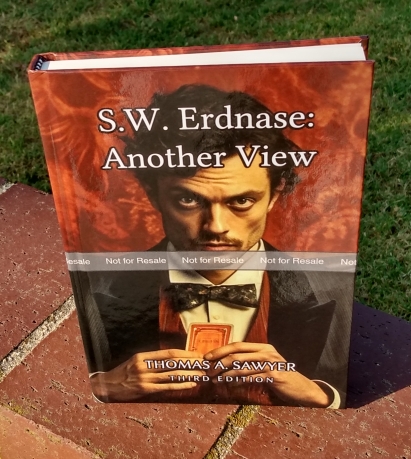
This will not be a comprehensive discussion of King Koko. I do, however, want to talk about certain aspects of the book from a bibliographer’s point of view (and from that of a book collector). The first edition was published in late 1904. (The Saturday Review for November 19, 1904, lists the book under the heading “This Week’s Books,” in the “Christmas Books” category. The Academy and Literature for the same date lists it under “New Books Received,” in the “Juvenile” category.)
I tend to think that the book was doomed ab initio by its title. To most people, the term “King Koko” means less than nothing. Back in 1904 and 1905, I imagine the situation was the same. There was a King Koko of Nembe, and it seems possible (or even likely) that Hoffmann thought it would be fun to use that name for one of his characters and for the title of the book.
My dear daughter, Elizabeth, created many images for possible use on the cover of the third edition of S.W. Erdnase: Another View and the 2023 version of Rethinking S.W. Erdnase. I liked a lot of those images quite a bit. She made them with the assistance of an AI program called Midjourney. Now, Midjourney is a great tool for many things, but for the types of covers I was interested in (for those two Erdnase-related books), few if any of the Midjourney images would have been useable without a noticeable amount of editing in Photoshop.
The images below would likely have required many hours of editing—unless I had simply said, “Oh, well, I can overlook all the problems, as long as the cover looks cool.” And honestly, I would have been justified in taking that attitude, since I have always anticipated that the audience for those two Erdnase books would likely be on the small side. However, I didn’t want to “settle.” In the end, I had two basic guidelines in selecting the images. They had to be images that Elizabeth liked, but which didn’t require massive amounts of work.
But below are some “fun” covers that Elizabeth and I concocted—mainly Elizabeth, since all I really did was crop them and add the wording. I might conceivably use one or more of these basic ideas in the future, maybe with different titles. With one exception, to be noted, I have placed these in the approximate order in which I favor them (best first, least-best last). That reminds me of the movie No Time for Sergeants, where the recruitment guy is having the recruits fill out their names, “last name first, first name, middle name last,” or something like that, leading to funny results for Will Stockdale’s carrying out of that instruction.
The exception is the fifth version shown. It’s really of a different “genre,” and I’m not sure how I would rank it. The first four are more like something out of an Alice-in-Wonderland dream. The fifth is more like a traditional-style.
At the moment, I’m not going to point out the things that would require editing. Some of them are obvious at a quick glance, and others are a bit more subtle.

Back in April, I mentioned on the Erdnase thread of the Genii Forum that I was working on a reprint of S.W. Erdnase: Another View. I’m now almost at the end of my work on getting that out and for sale. At the moment, I am awaiting proof copies from Amazon. As seems to be the norm with me, the project was far more time-consuming than I had expected, and I’m glad to be basically done with the writing for this edition. It turned out to be much more that a reprint, since I added a few chapters, and a new preface, and also I put together a lot of annotations.
[NOTE (August 1, 2023): As I explained in detail in another post, I received the proof copies, and they look fabulous, but for various reasons that project is essentially on hold. I haven’t looked at those proofs since the day they arrived, and I don’t know when I will continue to review them (if ever, LOL). That revised version might not appear at all, and if it does, it will likely be 2024 or later.]
Anyway, as part of the wrap-up, I figured that the book needed a frontispiece, and I decided (provisionally, at least) to use a version of the following image of buildings on Plymouth Place. (If I use it, it will be in black and white in the book.) This is of interest, because James McKinney & Co. had its business location on Plymouth Place.
The image below is from a post card. I have cropped it. I’m not certain when this image dates from. There are several versions that can be seen on the internet, including a few on eBay. Based on a quick survey by me, it appears that most of the post cards where this basic image is seen have not been mailed and hence have no cancellation date. The earliest date I saw on any of the internet images was on a post card that was hand-dated in 1905. The example I have was hand-dated in 1908.
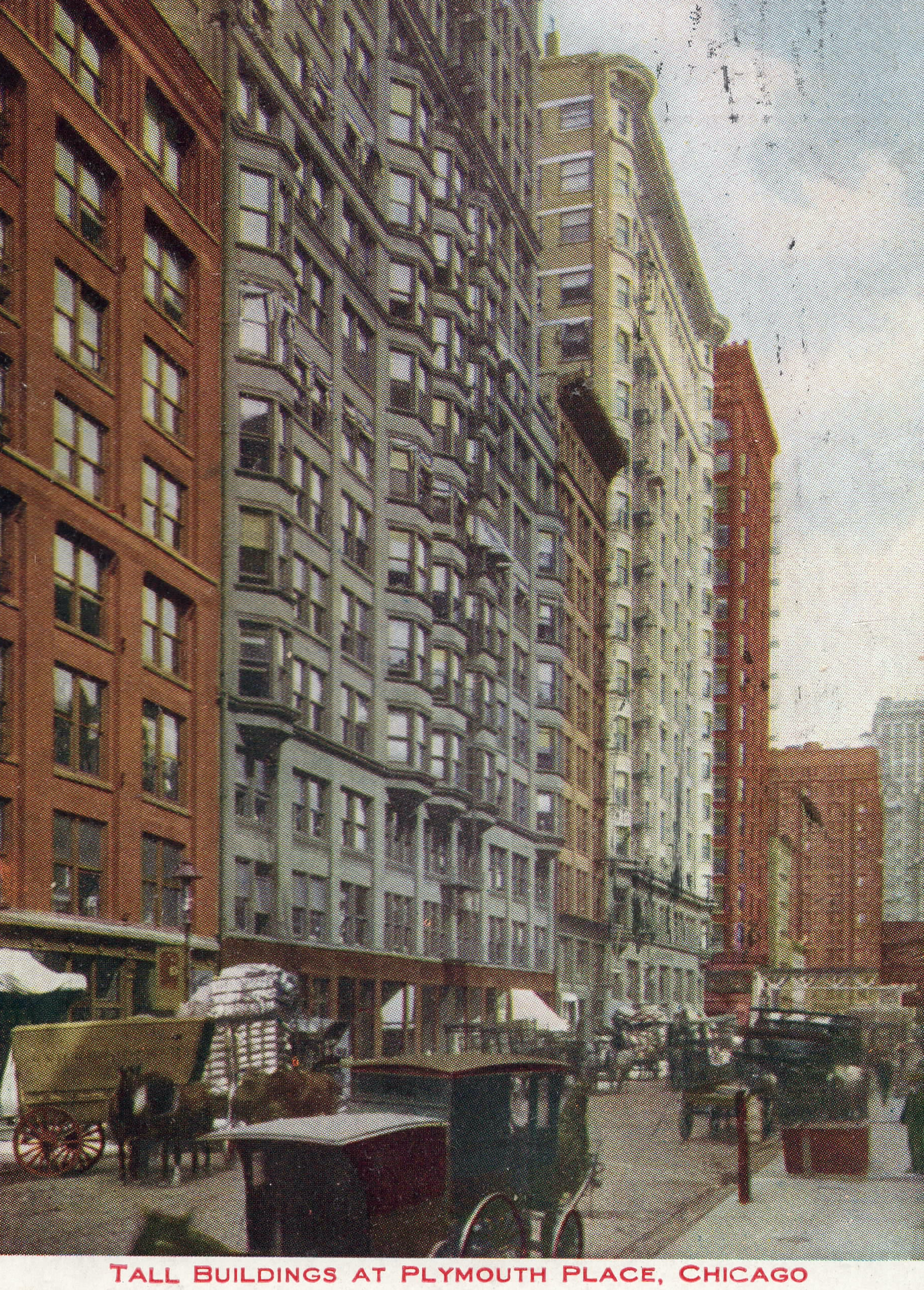
I made an effort to determine precisely what part of Plymouth Place is depicted in the image. After an arduous investigation, I arrived at a provisional guess.
From what I gather, Plymouth Place ran from Taylor Street* northward through Polk Street, then through Harrison Street, then through Van Buren Street (where the elevated train passed over it), and up to Jackson Boulevard, where Plymouth Place stopped. So, it was a rather short street (unless it continued somewhere after an interruption). (These statements are based on an 1898 map on a Library of Congress website.) Here is a section of that map, which I have marked up:

North is basically to the right on this map.
The green box at the left shows Taylor Street, which runs east and west (down and up).
The red arrow basically shows Plymouth Place, which on the map is almost completely obscured by buildings to the east (bottom of the map). The arrow starts after the “H” in PLYMOUTH, and the arrow’s point stops just before the word PLACE.
The yellow box is at Van Buren Street, and you can see the train route that passes over Plymouth Place.
The blue box shows Jackson Boulevard, marking the north end of Plymouth Place.
The following image from the same map shows (in larger size) the buildings on the west side of Plymouth Place, starting at the left from a point somewhat north of Harrison Street. You can see the elevated train’s route running vertically near the center of the image.

Here is the post-card image again, with some of the buildings labeled A through E. It is highly unlikely that the original photograph was in color, but it is possible that the colors shown were used by the colorist to approximate the actual colors. (I know for a verifiable fact that the colors in postcards of the era could differ wildly from the real colors, however.) I tend to assume that the colors on the map are indeed reasonably accurate. Anyway:
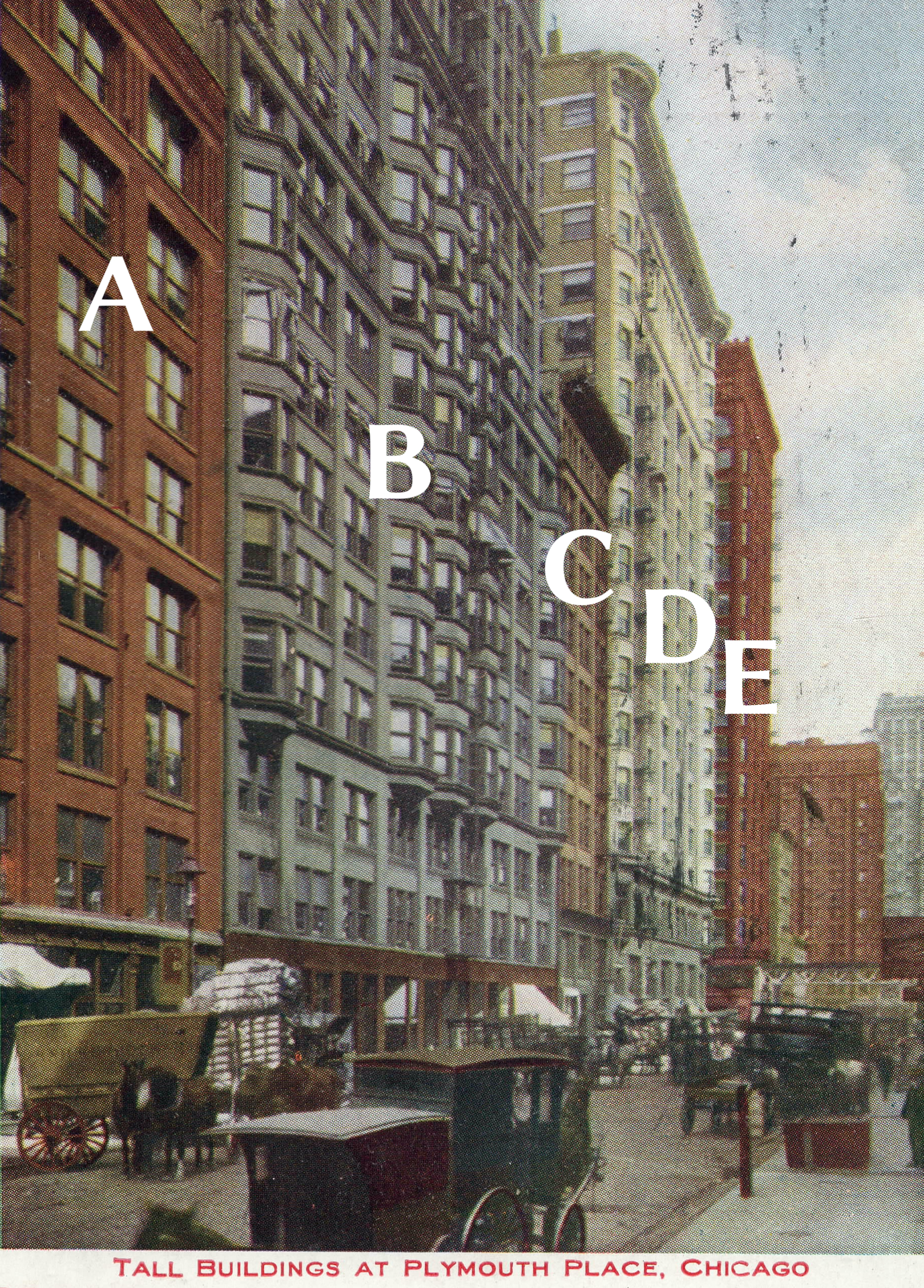
I think those last two buildings (unlabeled, at the far right of the image) are likely either (a) not on Plymouth Place (especially the one on the far right), or (b) at least are very near the north end of Plymouth Place.
Here is an image from the map again, with certain buildings labeled. I think it is likely that the labels on the buildings above correspond to the labels on the buildings shown below.

I think James McKinney & Co. was likely located (very approximately) to the right of the photographer. The 73-75 address of McKinney was on the east side of Plymouth Place, somewhat north of Harrison.
*(It’s possible that Plymouth Place ended a little further south than indicated above. Elsewhere I have stated that it ran northward from 12th Avenue.)
—Tom Sawyer
July 23, 2023
Very slightly revised: August 9, 2023
As recently as last night, I had assumed that the third edition of S.W. Erdnase: Another View would appear before my reissuing of Rethinking S.W. Erdnase. As I write this, it is now 12:27 a.m. on Friday, which to me is basically Thursday. And it was Wednesday (I would guess less than 28 hours ago) that I posted this:
I am also hoping to issue a reprint of my Rethinking S.W. Erdnase in the very near future. For that one, there was another batch of “rejected” cover ideas, and I’ll probably post a few of those soon.
Anyway, Amazon approved everything with no hitches and no delays, and the book was available less than twelve hours after I uploaded it.
All right then, my task is now to convince you that you should purchase a copy. Here are the basic stats:
First, here is what the front cover looks like on this book:
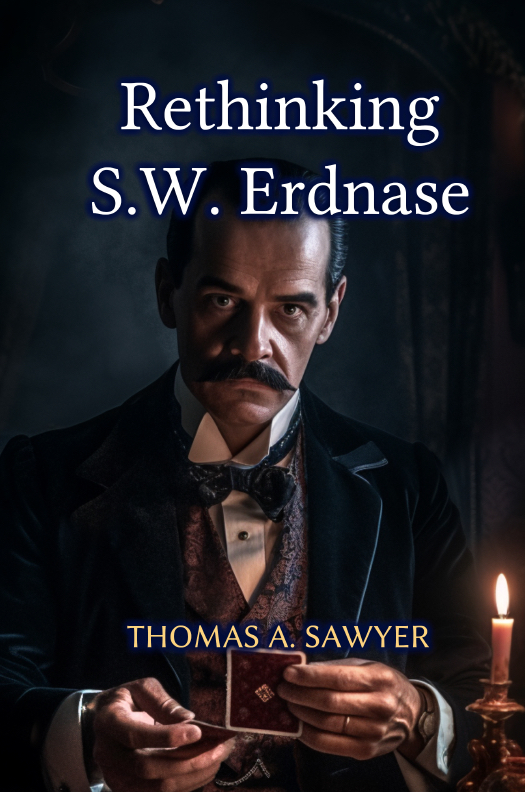
I have to thank my daughter, Elizabeth, for the image, which she put together with a program called Midjourney. (In this case, I beliieve she did a significant amount of modifying in Photoshop.)
Here are some reasons for you to consider obtaining a copy, adapted from a list of reasons I wrote when I was pushing the first edition, back in 2015:
For those of you who may be on the fence, here are some reasons you might want to consider buying a copy of my book Rethinking S.W. Erdnase:
1. This book has what I think is the most in-depth discussion of different approaches that might be considered in attempting to figure out who S.W. Erdnase was. Many people probably tend to “shoot from the hip,” and to use intuition and common sense. Those are not necessarily the best tools out there.
2. The book has a fair amount of information relating to Frederic J. Drake & Co., including images relating to the 1912 Drake catalog (as found in the 1912 Publishers’ Trade List Annual).
3. The frontispiece is basically a portrait of Frederick J. Drake based on his image in the 1912 catalog referred to.
4. My book has information about tenants of 73 Plymouth Place in addition to James McKinney (the apparent printer of the first edition of The Expert at the Card Table).
5. One of the things this book does is to attempt to place the Whaley-Gardner-Busby book (The Man Who Was Erdnase) into context. In the course of this new book, the Whaley-Gardner-Busby book is the subject of criticism relating to Whaley’s general approach in writing the book and the weaknesses of the main conclusions of the book.
6. Rethinking S.W Erdnase looks at the cases of three of the main candidates (Edwin Sumner Andrews, Milton Franklin Andrews, and Wilbur Edgerton Sanders), to demonstrate some of their main strengths and weaknesses. I hope that discussion will be considered helpful in the evaluation of other candidates.
7. Did Marshall D. Smith really illustrate The Expert at the Card Table? Was he really the “M.D. Smith” of the title page? I’m sure he was—well, pretty sure—but are there any reasons for doubting that? I explore this issue in much greater depth than I have seen elsewhere.
8. Above all, this book is a fairly cool Erdnase-related item, dealing largely with the authorship issues. I know there is a lot of Erdnase stuff out there, but there is relatively little in the way of hardcover books dealing mainly with that topic.
Here are images of a few pages. (The gray borders do not appear on the actual pages.) You can see more pages on the “Look inside” feature on Amazon:
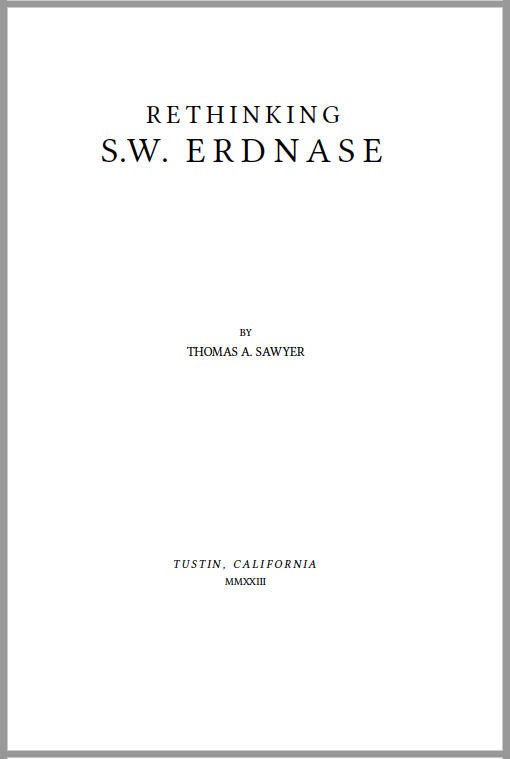
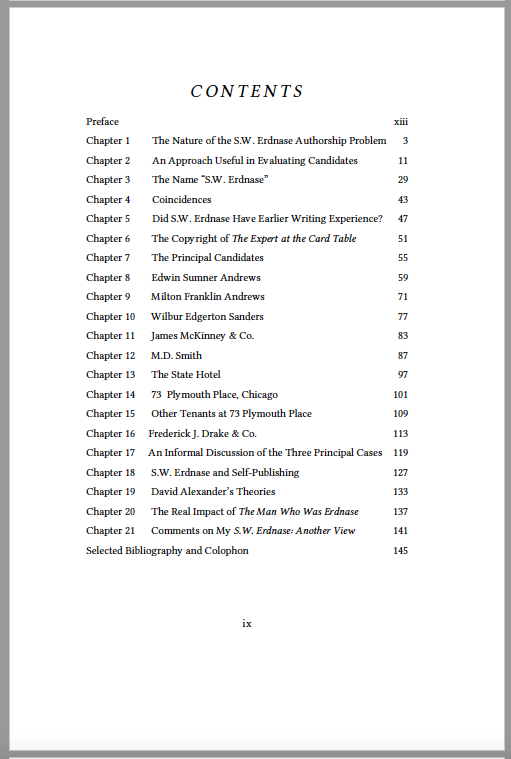
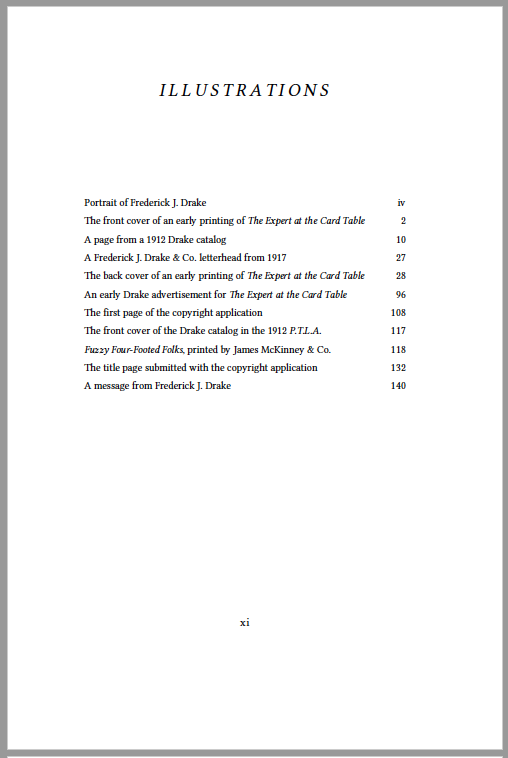
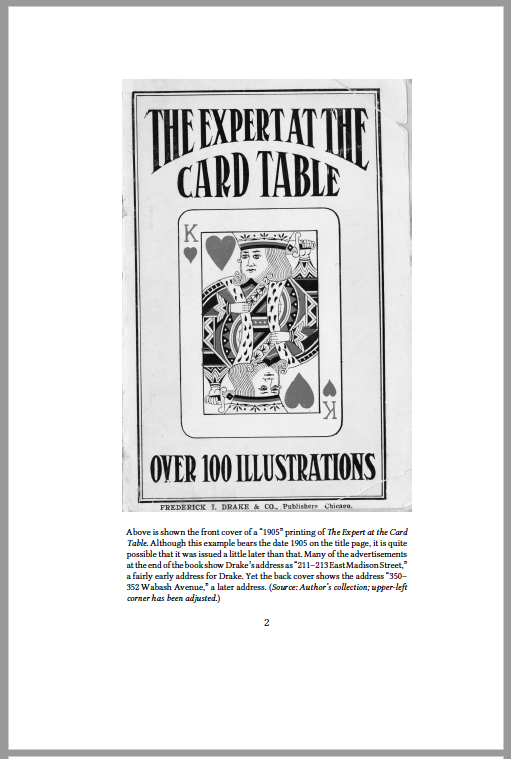
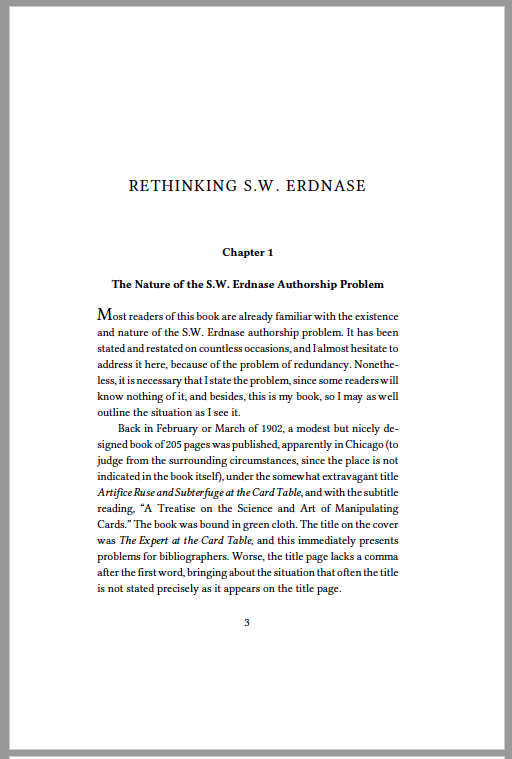
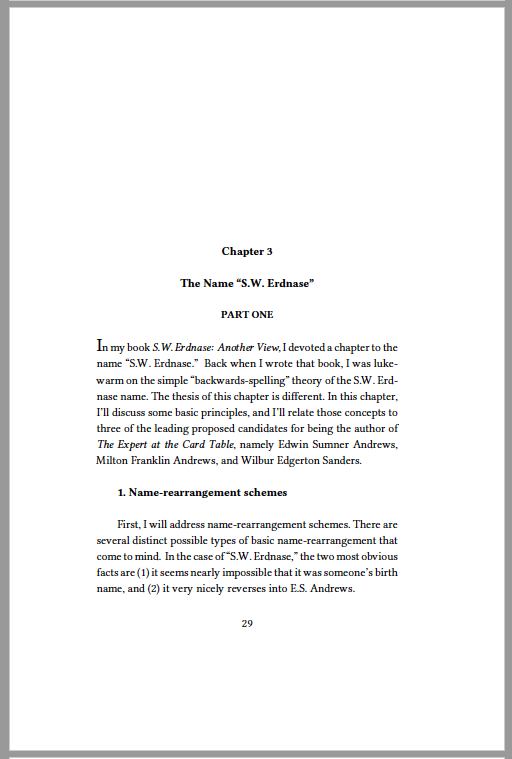
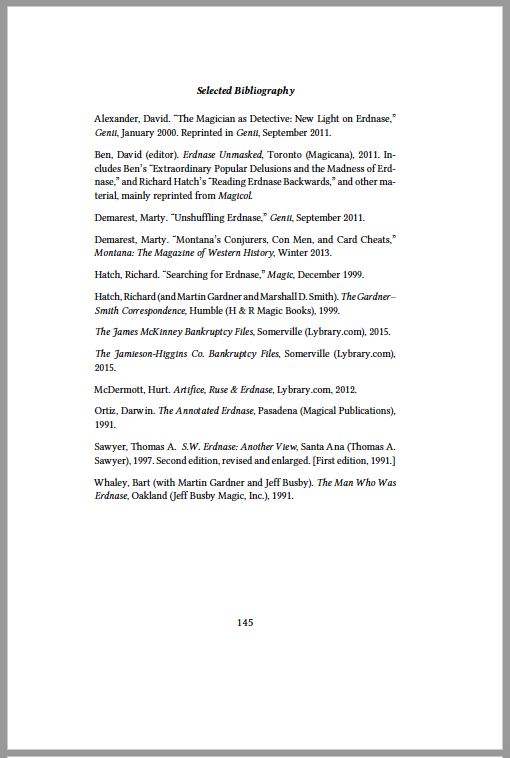
Oh, no! I just noticed that the table of contents indicates that there is a colophon on page 145. That’s not so, since that colophon only applied to the first printing. I mention this in an author’s note.
You may wonder, “Does the text differ from that of the first printing?” The short answer to this is: “No.” A longer answer is that I made changes to only five pages, and those changes were mainly those that seemed essential. Examples: change of date on title page; change in copyright notice; change in website; deletion of colophon (a very brief note which contained information about the quantity and printer of the first edition, and similar information). There are also two notes by me that seemed necessary (or at least desirable).
That’s all for the moment! It’s now 2:31 a.m.!
—Tom Sawyer
July 21, 2023
The Jamieson-Higgins Co. was closely tied-in with James McKinney & Co., the presumed printer of S.W. Erdnase’s The Expert at the Card Table. McKinney printed some (possibly many) of the books published by Jamieson-Higgins, and, as is mentioned on the Erdnase thread of the Genii forum, James McKinney may have been a major stockholder in Jamieson-Higgins (see The Bookseller, January 1903).
Of special interest is the now well-accepted fact (demonstrated by Dick Hatch, with additional support from Bill Mullins) that S.W. Jamieson filled out copyright paperwork in connection with The Expert at the Card Table. Just what the significance of that is, has not really been demonstrated (yet!).
Stillman B. Jamieson was also involved with Jamieson-Higgins, and according to the Erdnase thread (I think based on research by “mam”), he was S.W. Jamieson’s brother. I don’t know what S.W. looked like, but here is an image of Stillman, on a Library of Congress website, from the December 1, 1900, issue of The Chicago Eagle:
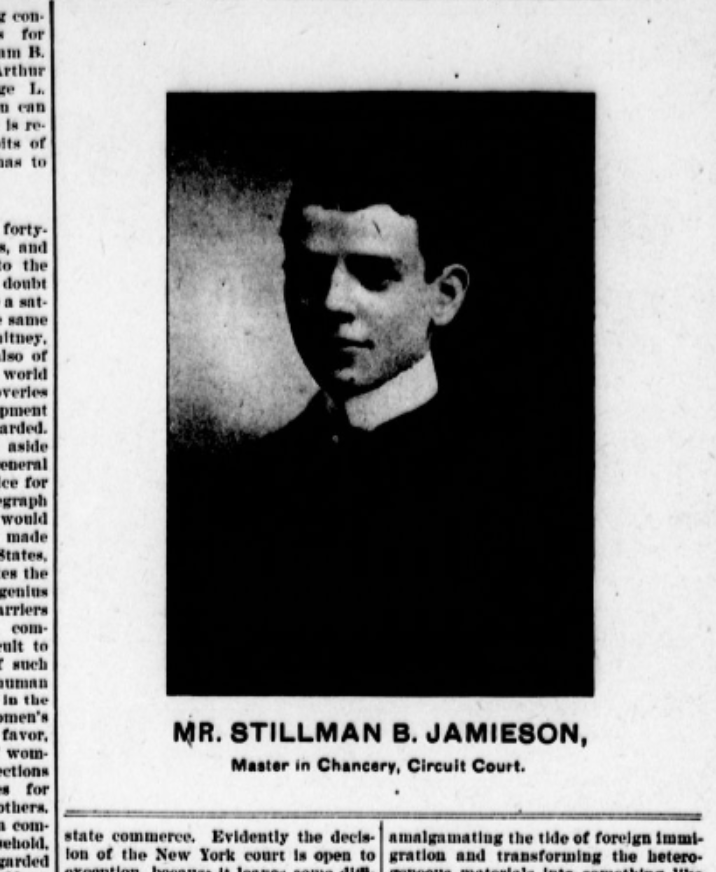
—Tom Sawyer
July 14, 2023
July 17, 2023 note: On the same page of The Chicago Eagle (linked-to above) is a rather interesting little article about Stillman.
In recent posts, I’ve talked about the Villanova University website (Falvey Library). In this post, I’ll explore that library’s digital holdings a little further. There I found that the library has a large number of digitized issues of Golden Days for Boys and Girls, a Philadelphia periodical that ran Professor Hoffmann’s The Young Wizard in 1887 and 1888 (after it ran in The Boy’s Own Paper).
The fact that The Young Wizard ran in Golden Days isn’t what I would call new and revolutionary information. Stanyon mentioned Golden Days in connection with The Young Wizard in the May 1902 issue of Magic (viewable on Google Books). Stanley Collins mentioned the Golden Days serialization in an article in The Magic Cauldron, October 1966, but it seems he had the years wrong. (Stanyon’s listing is a little misleading on the years, as well.) Also, I myself discussed this topic in my 2016 book Professor Hoffmann and His Conjuring Serials of 1872-1888.
Nonetheless, I think I can say that detailed information about this version of The Wizard’s Tower has not been readily available. At least, I do not know of any detailed treatment of this particular serialization.
Below are two relevant screenshots from the Villanova University website just mentioned. (“Attribution: Digital Library@Villanova University.”)
Above is shown the top of the first page of the first issue of Golden Days to carry the serialization of The Young Wizard—the October 29, 1887 issue.
Above is the beginning of the first part of The Young Wizard as it appeared in Golden Days. The text is quite noticeably different from the corresponding text as it appeared in The Boy’s Own Paper. Above we have a literate bird intently reading an issue of Golden Days, while at the same time serving as the capital “I” in the word “It.” In the first article in The Boy’s Own Paper, the first word is “Ambition.” The beginning of the Golden Days version has been revamped, with some text omitted completely.
In my collection, I have a bound volume of Golden Days that begins with December 3, 1887, and ends with November 24, 1888. That includes all of the articles of The Young Wizard starting with Part VI, in the December 3, 1887, issue. In my book on Hoffmann’s conjuring serials, I said it appeared likely to me that the first part appeared in the October 29, 1887, issue, which turned out to be right! The digitized version on the Villanova website was my first opportunity to see that first issue.
—Tom Sawyer
June 25, 2023
I am excited to announce that I have recently (within this past week) published my own edition of The Wizard’s Tower, by Professor Hoffmann (Angelo J. Lewis). It’s a lengthy work of fiction by Hoffmann that has remained almost unknown to those interested in Professor Hoffmann—for well over a century. This is the work’s first publication in book form, and in fact, I would actually be surprised if there are any other Hoffmann collectors who have seen the work in Cassell’s Saturday Journal. To the best of my knowledge, that was where it was originally published (during January and February 1887)—although in the book I also discuss two serializations of The Wizard’s Tower in Tasmania in 1890.
In my most recent post, I discussed the Modern Magic extract that appeared in the January 10, 1876, issue of The Boys of New York. In this post, I’ll talk briefly about the Modern Magic extract that appeared in the issue of the following week, namely the January 17, 1876, issue. Once again, I am relying on a website of Villanova University (Falvey Library) in discussing The Boys of New York, and for the images below from The Boys of New York.
When compared to the separate volume of Modern Magic, the text from the January 10 issue ends about one third of the way down on page 311 of the book. The current extract (January 17) picks up where the earlier one left off. The corresponding text of the book ends about a third of the way down on page 313.
Again, I haven’t compared the text of The Boys of New York to the separate volume with any real care. (For the limited comparisons I have done, I have been using one or more digitized versions of the book on Google Books, since those are searchable, and far more convenient than using a volume from my collection. Also, it doesn’t impose handling on any of my books.)
Here is a fact that I think few other people (if any) are aware of, as of the time I am posting this:
Portions of Modern Magic appeared in a New York publication titled The Boys of New York, in early 1876. This is true of at least five issues of the periodical, including four issues in January 1876 and one in February 1876. Over in London, the final installment of Modern Magic in Every Boy’s Magazine appeared in the July 1876 issue. (That was the “monthly part”version. I think there may have been a “weekly number” version as well.)
In this post, I’ll outline the bare bones of the situation. In future posts I’ll probably get into this in more detail.
One of the search results for “Professor Hoffmann,” on the Villanova University (Falvey Library) website, is for a periodical called The Boys of New York. That result represented one Hoffmann item in that periodical. By further digging on that website, I have also found four other Hoffmann items in The Boys of New York, which can be seen on the Falvey Library website.
Continue readingI’m pretty sure that new discoveries regarding Professor Hoffmann’s works still remain to be made, more than a century after his death in late 1919. In my next post, I’ll talk about a discovery I made recently, which was quite surprising to me and which has modified my thinking about the original appearance of Modern Magic. It has also suggested to me an additional avenue for research into Hoffmann’s works.
I’ll try to post something soon about that discovery!
—Tom Sawyer
June 22, 2023
Edited 6-23-23
Thanks for visiting! This blog has been dormant for I don’t know how long! Probably since not long after the most recent post, which was eons ago.
This is just a quick post. I need to through the posts below and see which ones I want to keep “as is,” and which ones I want to edit—and also which I want to delete (or make private). I’m pretty sure that some of them I have already re-used elsewhere, either in books or other blogs.
For more information about my plans for this blog, check out the “About” link above.
—Tom Sawyer
June 21, 2023
One of the main difficulties that exists in connection with the S.W. Erdnase authorship problem is that which I alluded to in an earlier post.
Here I will state clearly why the identity of S.W. Erdnase will (probably) never be demonstrated clearly and to the satisfaction of 99 out of 100 people, under the current circumstances–other than by pure luck.
1. Not enough people are interested in doing any research at all on the subject.
2. Not enough people are interested in doing the right kind of research.
3. Not enough people are interested in doing “off-the-beaten-path” research.
4. Sorry, but not enough people know how to reason effectively and draw sound conclusions.
5. Too many people who are interested in the subject do not have a command of the basic relevant facts.
6. A lot of the Erdnase authorship-research is of the right kind, but it often stops short (the follow-through on decent leads is often missing).
7. This may be a little subjective, but I think that a lot of people have a great deal of difficulty in determining when a proposition has been “proven” (yes, I know that the word can have many meanings). By the way, if anyone ever comes up with an incontrovertible case that S.W. Erdnase was a certain person, the one forwarding the candidate will not have to engage in any discussions of standards of proof–such discussions immediately imply the existence of a case that many people are going to reject.
Basically, though, not enough research is being done.
Another major reason is that there are not enough “obvious” sources of helpful information. If there were, then maybe answers would be found with the same kind of research that is going on now.
The only way that any really firm answers–I mean plain, unequivocal evidence that would be accepted by 99 out of 100 people–will be found (under the present state of things) is probably going to be by pure, blind, dumb luck.
—Tom Sawyer
October 1, 2012